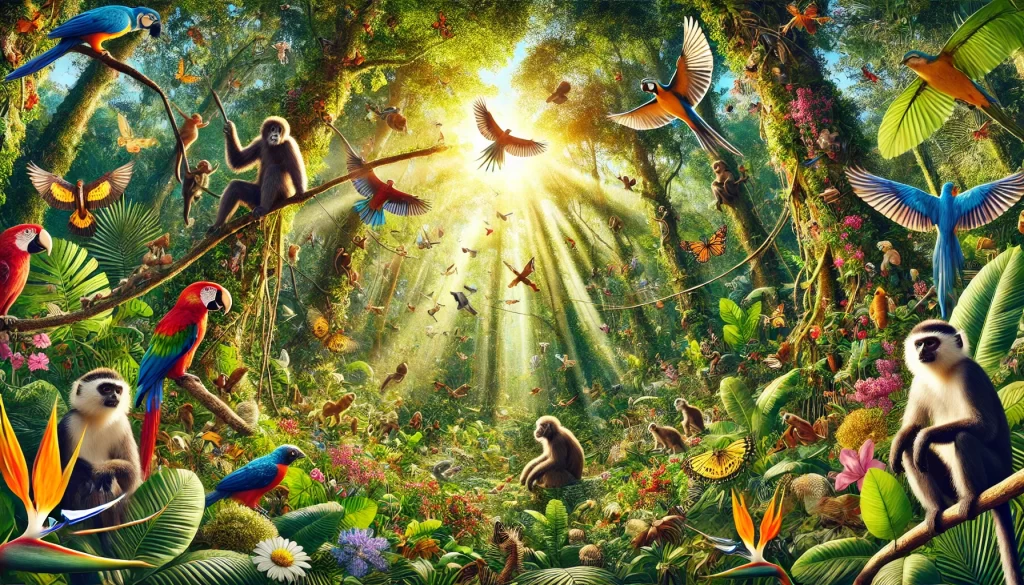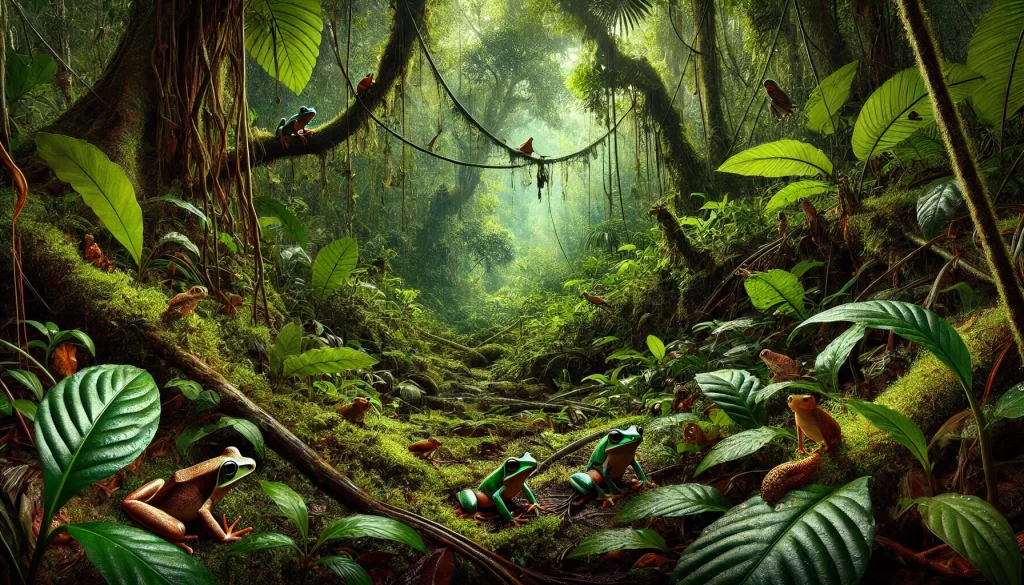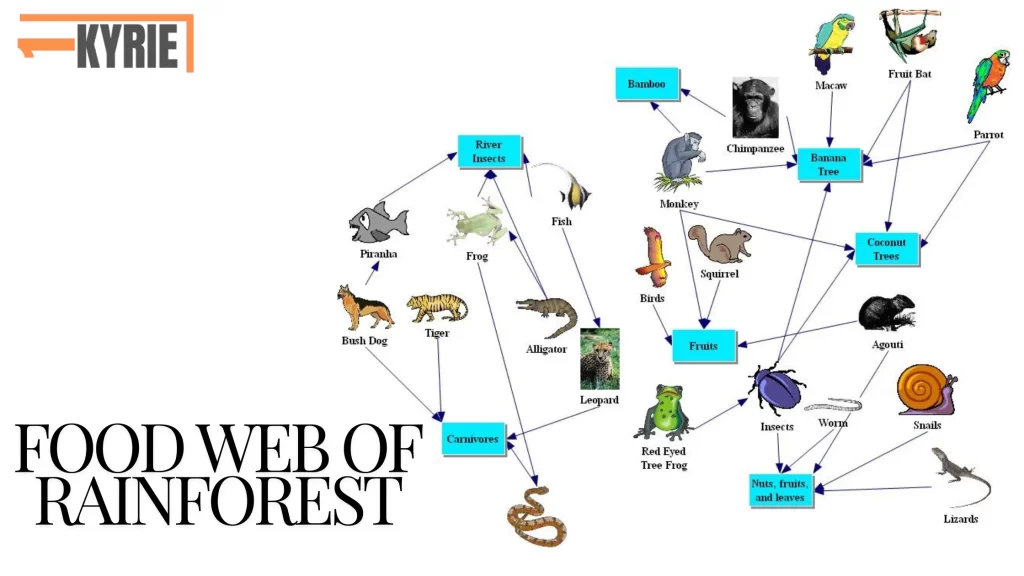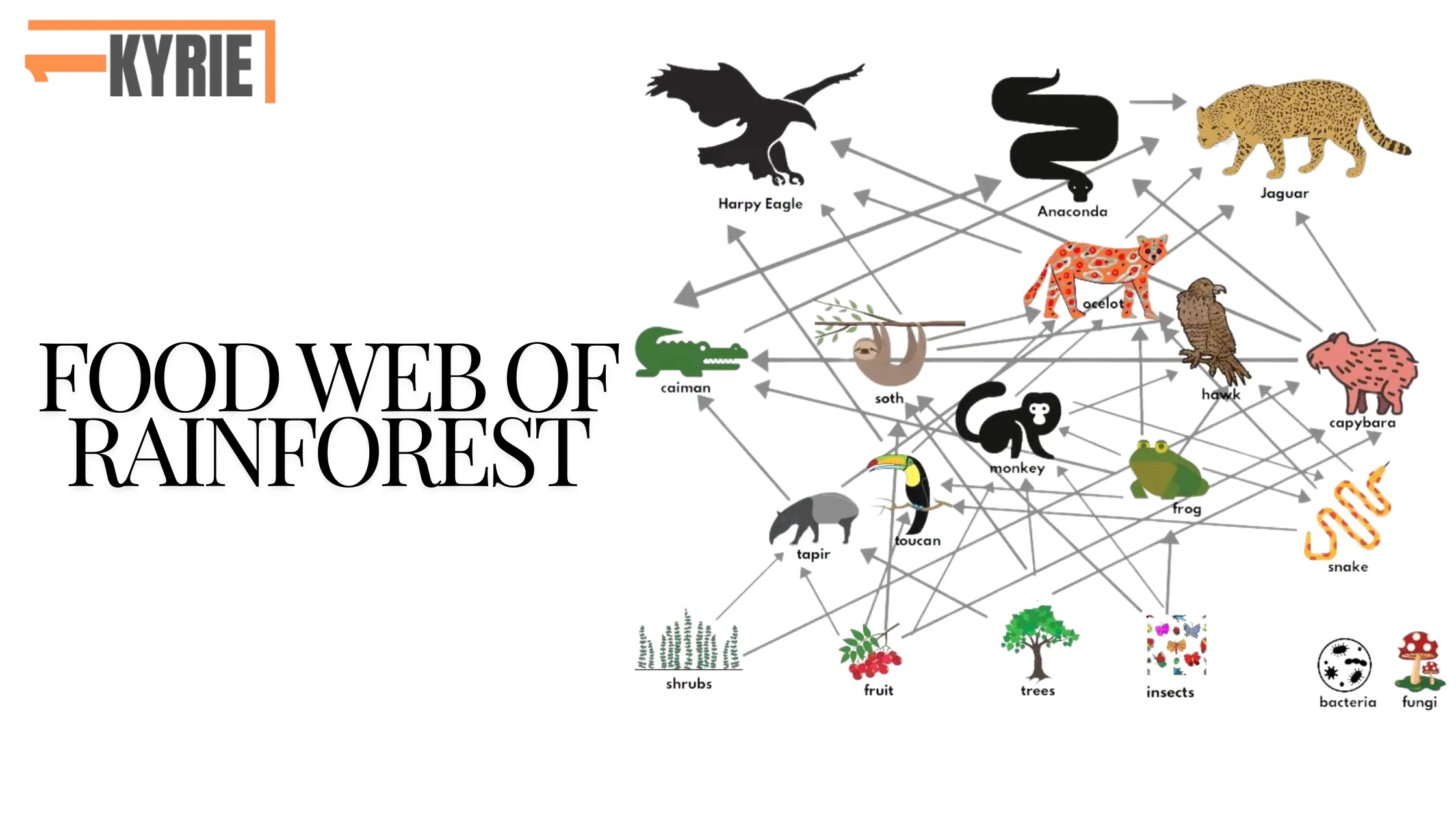Table of Contents
The Food Web of Rainforest ecosystems is a complex and vibrant network where every living being plays a crucial role. The rainforest has incredible diversity and life, from the towering trees to the tiniest insects. This hidden world is a whole of interconnections, where every creature, big or small, contributes to the balance of nature. This article profoundly explores the Food Web of the Rainforest, exploring the fascinating relationships that sustain this thriving ecosystem.
The Layers of the Rainforest: A World of Life

The Canopy: The Roof of the Rainforest
The canopy is the highest layer of the rainforest, where sunlight first meets the trees. It’s a bustling area teeming with life. Birds, monkeys, and insects thrive here, feeding on the abundant fruits and leaves. The canopy is vital in the rainforest’s Food Web, providing food and shelter to many species. The energy from the sun is captured by the leaves, which feed the herbivores, who then become prey for the carnivores.
The Understory: A Hidden World Beneath
The understory lies below the canopy, a shaded, humid environment where smaller plants and animals thrive. Here, the Food Web of Rainforest continues with various species adapted to low light. Insects, frogs, and birds find their niche, feeding on the leaves, fruits, and smaller animals. This layer is crucial for maintaining the balance in the Food Web of Rainforest, as it supports a different range of species that contribute to the overall health of the rainforest.
The Forest Floor: A World of Decay and Renewal
The forest floor may seem quiet, but it’s a bustling hub of activity. Here, the Food Web of Rainforest takes on a different form. Decomposers like fungi, bacteria, and insects break down dead plants and animals, recycling nutrients into the soil. This process is essential for growing new plants and eventually feeding the herbivores. The forest floor also houses larger animals like jaguars and tapirs, who play their part in this complex web.
Key Players in the Food Web of Rainforest

Producers: The Foundation of Life
At the base of the Food Web of Rainforest are the producers, mainly the green plants and trees. These organisms use sunlight to create energy through photosynthesis, the foundation for all other life forms in the rainforest. The leaves, fruits, and seeds produced by these plants are the primary food source for herbivores, making producers vital to the ecosystem.
Herbivores: The Plant Eaters

Herbivores, such as monkeys, sloths, and insects, play a critical role in the rainforest’s Food Web. They feed on abundant vegetation, turning the energy stored in plants into sustenance for themselves. These animals are, in turn, prey for the carnivores, making them an essential link in the food chain. The survival of herbivores ensures the transfer of energy from plants to higher levels of the rainforest’s Food Web.
Carnivores: The Predators
Carnivores are the hunters of the rainforest, keeping the populations of herbivores in check. Big cats like jaguars, birds of prey, and snakes are the top predators in this ecosystem. The Food Web of Rainforest relies on these carnivores to maintain balance, ensuring no single species dominates. Predation helps regulate the population sizes of herbivores, allowing plant life to flourish.
Decomposers: The Recyclers of Nature
Decomposers, including fungi, bacteria, and insects, are the unsung heroes of the Food Web of Rainforest. They restore essential nutrients to the soil by decomposing dead plants and animals. Without decomposers, the rainforest would be overwhelmed with organic matter, and the life cycle would be disrupted. These organisms ensure the continuous renewal of the rainforest, making them indispensable to the ecosystem.
The Interconnectedness of the Food Web of Rainforest
Symbiotic Relationships: Helping Each Other Survive
In the Food Web of Rainforest, many species form symbiotic relationships to survive. For example, certain birds eat insects that harm trees, benefiting both the bird and the tree. Another example is the relationship between fungi and tree roots, where fungi help trees absorb nutrients, and in return, they receive food from the tree. These relationships are crucial in maintaining the balance and health of the rainforest.
The Impact of Changes in the Food Web
Any disruption in the Food Web of Rainforest can have far-reaching consequences. For instance, the loss of a predator like the jaguar can increase herbivore populations, which may then overconsume vegetation, affecting the entire ecosystem. Similarly, removing decomposers would prevent the recycling of nutrients, leading to soil depletion and affecting plant growth. Understanding these connections highlights the importance of every species in the rainforest.
Also Read: Rap Songs with Food Lines: Discover Deliciously Dope Lyrics
The Threats to the Food Web of Rainforest
Deforestation: A Looming Danger
Deforestation is one of the biggest threats to the Food Web of Rainforest. When trees are cut down, the entire ecosystem suffers. The loss of habitat disrupts the lives of countless species, breaking the delicate balance of the Food Web of Rainforest. Animals lose their homes and food sources, and the life cycle is thrown into disarray. Protecting the rainforest is crucial for preserving this intricate web of life.
Climate Change: Shifting the Balance
Climate change is another significant threat to the Food Web of Rainforest. Changes in temperature and rainfall patterns can alter the growth of plants, affecting the entire food chain. Species that cannot adapt may decline, leading to a ripple effect throughout the ecosystem. Preserving the rainforest is essential not only for the species that live there but also for the health of our planet.
The Food Web of Rainforest is a thriving, hidden ecosystem, full of life and interconnectedness. Every species, from the smallest insect to the largest predator, plays a role in maintaining the balance of this complex web. Understanding and protecting the Food Web of Rainforest is crucial for the survival of these incredible ecosystems. As we continue to learn more about this vibrant world, we can better appreciate the importance of every living being within it. Preserving the rainforest ensures that this remarkable web of life thrives for generations.

